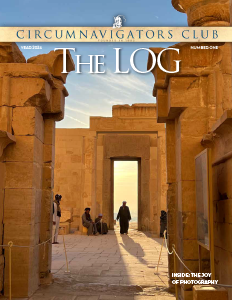Article in the Wall Street Journal, August 7th on the front page of the Personal Section
The Guide to Round-the-World Tickets
Fliers Find More Options for Taking the Circular Route Home, With Plenty of Stops Along the Way
By
Scott McCartney
Traveling around the world has become cheaper and less unique, and some airline alliances are selling Round-the-World fares, which can yield more savings for travelers. WSJ’s Scott McCartney joins Lunch Break with Lee Hawkins with the details. Photo: iStock/ViktorCap
Bucket lists often involve partaking in exotic adventures or celebrating at famous landmarks. Just saying you traveled completely around the world can also be a lifetime accomplishment-and it’s getting easier and cheaper than ever to do it.
Circumnavigation, the great badge of traveler sophistication, is experiencing a revival among 20-something modern-day Phileas Foggs. More global business travelers are also going truly global. They often find they can get home quicker by continuing in the same direction instead of returning the way they came, or adding a vacation stop and turning a trip into a round-the-world exploration. Some say it lessens jet lag. Others always go west-to-east so flights are speedier with tailwinds.
“It’s getting more and more common with my friends. At first it was cool. Now it’s becoming less and less of a unique thing,” said Tyler Narveson, a 28-year-old consultant from Nashville, Tenn., who travels frequently.
With long-range Boeing BA +1.43% and Airbus jets now in regular service and airlines flying longer and longer nonstop routes, jetting around the globe can be done with just a couple of airline connections.
The three major international airline alliances-Star, Oneworld and SkyTeam-offer round-the-world tickets with big savings on long trips that touch multiple continents and involve multiple airlines, especially on popular business-class and first-class journeys. Star Alliance added more options to its round-the-world ticket choices in May; Oneworld says it’s selling hundreds of thousands of round-the-world tickets a year-with almost as many for travel in first- and business-class as in economy.
The cheapest round-the-world fare on the Star Alliance is $3,623, which covers up to 26,000 miles and requires three to five stops. The most expensive ticket-first-class with as many as 15 stops and 39,000 miles-costs $22,278. (The earth’s circumference at the equator is 24,901 miles.) The tickets usually require travel all in the same direction, that the Atlantic and Pacific oceans be crossed and that the traveler use up the ticket within a set period. Bargain hunters can often do even better booking trip legs separately with frequent-flier miles or tickets on discount airlines.
Among hard-core fliers, achieving the highest tiers in airline and hotel loyalty programs is routine. But within online communities like FlyerTalk.com, where travel junkies swap tips, tales and gripes, what separates the great travelers from the frequent are the special accomplishments, like the ‘Round The World Club and the Century Club-those who have visited 100 countries.
“Around the world is the second-best achievement a frequent flier can achieve, after 1 million miles,” said Dan Alexander, who flew 27,000 miles over eight days, all using frequent-flier points.
Mr. Alexander, 24, who lives in Seattle and travels frequently for a consulting company, saw the sun set twice on a June flight that left Los Angeles at 5 p.m., flew over Canada for the first sunset and arrived in Dubai at 9 p.m. the next day after a sunset over Eastern Europe. He spent only five nights of the trip in hotels. One of the highlights was the in-flight shower he took in the first-class cabin of an Emirates superjumbo jet.
“It’s almost a fraternity aspect-to be able to say, ‘Yes, I’ve traveled around the world,’ ” he said.
There is a fraternity called the Circumnavigators Club, a New York-based social club founded in 1902 with chapters around the world. The largest chapter is in Naples, Fla., reflecting the club’s aging demographic.
The Circumnavigators Club, once an elite lot with members like Harry Houdini, William Jennings Bryan and Gen. Douglas MacArthur, has a foundation that awards scholarships to college students to travel around the world and report back. To become a member, you must have crossed all the lines of longitude in one direction.
“Circumnavigating in 1902 was very, very different. Today, you just need the money and the will to do it,” said David Mink, chair of the group’s communications committee. He has made five trips around the world and plans another next year with his daughter and granddaughter.
The club has 700 members who pay $150 a year in dues, with membership growing, he said.
Paul Boddorf travels to Thailand a couple of times a year. He circumnavigates out of practicality: Flying west to east means he can always follow weather patterns and have a tailwind. Flying into a headwind can add an hour or more to many long flights.
Mr. Boddorf, who lives in Pearl River, N.Y., and is retired from the corporate world, spends one out of every three weekends on a mileage run, flying from New York to the West Coast to accumulate miles and status on United. Then he cashes in the miles for business-class and first-class tickets to Thailand. He typically flies United or Lufthansa LHA.XE +0.55% to Europe to connect with partner Thai Airways THAI.TH +5.23% to Bangkok, then comes home to New York through Japan or South Korea.
Spending about $3,000 on domestic trips got him top-level status on United and more than enough miles for a first-class ticket to Thailand worth $15,000 or more. But United’s frequent-flier program is changing. Miles will be awarded based on fare paid rather than distance traveled, which will end his mileage gambit. “I looked at it as a hobby,” he said.
In May, Star Alliance, which was founded by United, Lufthansa and others, added four new round-the-world fare levels, raising the total offerings to 14. The additional levels better match traveler trips, since some customers were paying for miles and stops they weren’t using, spokesman Markus Ruediger said. Travelers can tailor tickets by distance, stops and class of service.
More than half of Star’s Round the World fares are sold in business class-from $8,509 to $13,304-and 8% are sold in first class. Coach accounts for more than one-third of tickets sold, Mr. Ruediger said.
Oneworld offers multiple “Explorer” round-the-world fares based on the number of continents you visit rather than miles flown. It also offers several package fares that don’t require circumnavigation but let you visit multiple continents or multiple destinations on the same continent. Prices for the Explorer fares vary depending on continents, class of service and time of year. Trips can be for a minimum of 10 days and a maximum of one year.
Mr. Narveson, the Nashville consultant, used American Airlines frequent-flier miles for a Oneworld Explorer award: For 130,000 miles, he could fly business class around the world with multiple stops. American discontinued the award in April.
He’s circumnavigated multiple times, often adding destinations to take advantage of cheaper fares, and sometimes combining vacations with work trips and using frequent-flier miles to cover the vacation legs.
“The first couple of times it was cool to do it. Now I realize it’s more convenient,” he said. If he’s in Asia on business, he can ease his way back through time zones if he goes through Europe, usually for the same price as flying through Japan.
To find cheap flights, he looks at airport websites to see all the airlines that serve that destination. His personal goal: visit 100 countries. He’s been to 54 so far.










